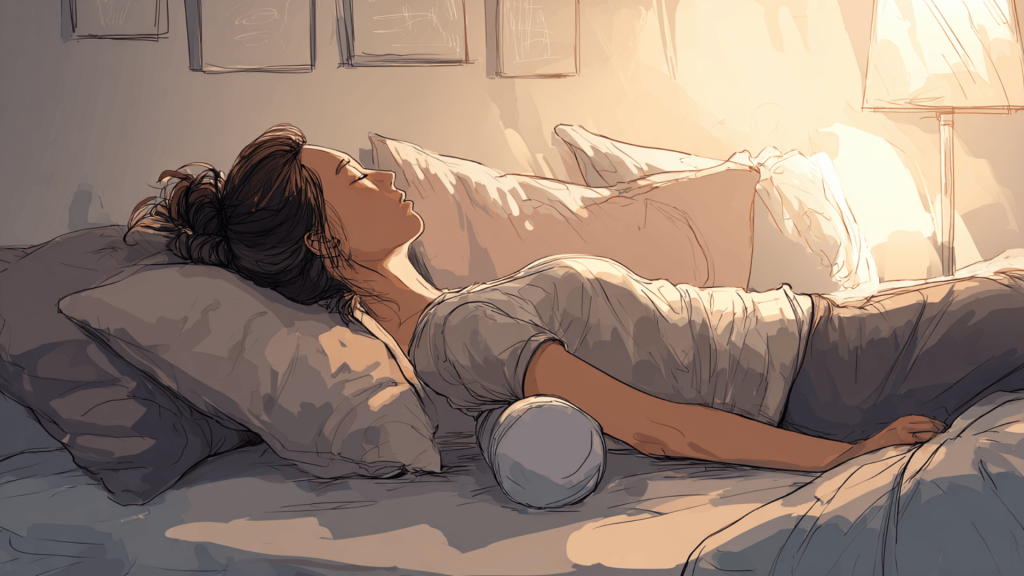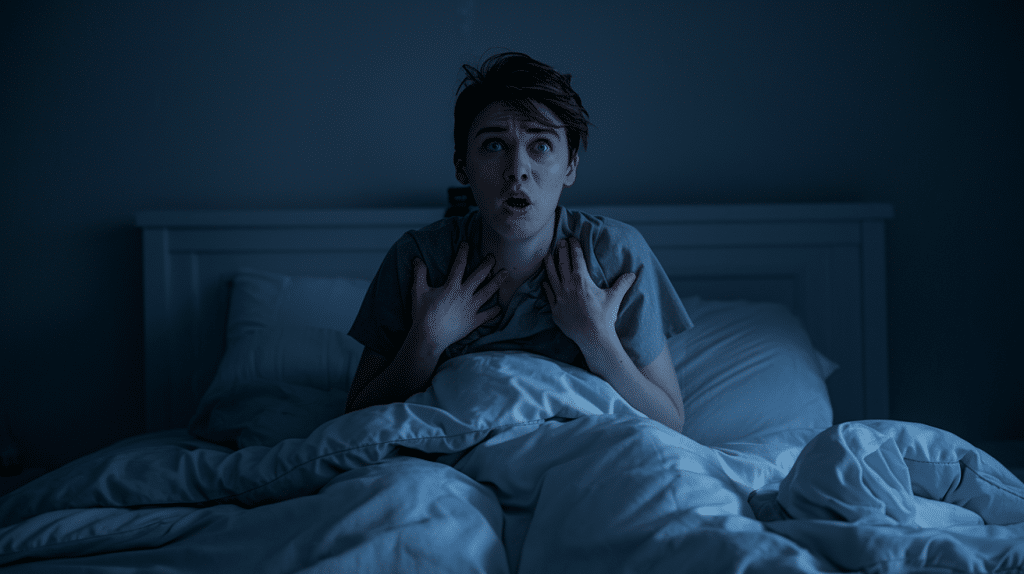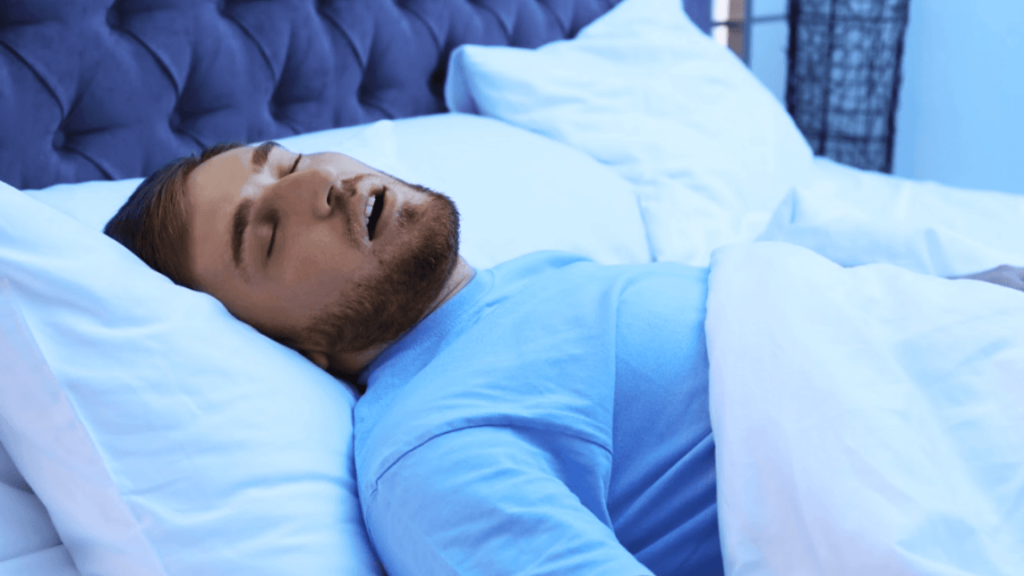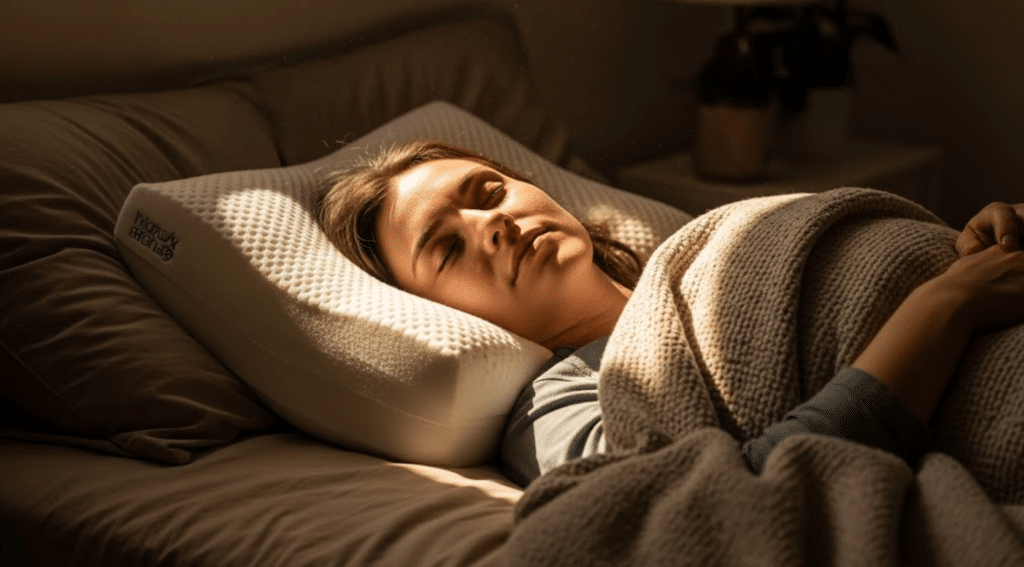Struggling to fall asleep because of that nagging ache between your shoulder blades? I’ve dealt with that too, and I have a pretty good idea of what you’re going through.
Sometimes, the way you sleep is part of the problem. Rhomboid pain often shows up from poor posture, stress, or even how you position yourself in bed each night.
The good news? You can make it better with a few simple changes. I will walk you through the best rhomboid pain sleeping position, explain why posture matters even while you sleep, and point out what to avoid.
I’ll also share easy tips for stretching, pillow support, and daily habits that help keep the pain away. Let’s figure out what your body actually needs tonight.
What is Rhomboid Pain?
Rhomboid pain is a common type of discomfort that shows up between your shoulder blades. It can feel like a deep ache, muscle tightness, or even a sharp, pulling sensation in your upper back.
This pain often makes simple movements, like turning your head or lying down, more difficult and uncomfortable.
Rhomboid Muscle Location and Function
The rhomboid muscles are located in your upper back, sitting between your spine and shoulder blades.
You have two on each side: the rhomboid major and rhomboid minor.
These muscles help pull your shoulder blades toward your spine and hold them in place. They also support posture and allow you to move your upper back and shoulders in a controlled way.
The rhomboids come into play when you perform actions like pulling, lifting, or sitting upright for long periods. If these muscles get strained or overworked, they can become tight, sore, or inflamed, leading to pain and limited movement.
Symptoms of Rhomboid Pain
People with rhomboid pain often describe it as a dull, nagging ache or tightness between the shoulder blades. In some cases, it can feel sharp or burning, especially when twisting your torso or moving your arms. You might also feel stiffness or muscle knots in the upper back area.
This pain may come on slowly from poor habits or suddenly from a strain. For some, it feels like the back needs to “crack” or loosen up. The discomfort may get worse at night, especially if you sleep in certain positions.
Common Causes of Rhomboid Pain
This pain often comes from everyday habits that strain your upper back.
Some of the most common causes are:
- Poor posture: Slouching while sitting, looking down at your phone, or hunching over a desk
- Overuse or repetitive movements: Lifting, rowing, or working out without proper form
- Stress and tension: Emotional stress can cause muscles to tighten
- Sleeping positions: Sleeping on your stomach or in positions that twist the shoulders
- Weak core or back muscles: These can throw off your body’s balance and strain the upper back
In some cases, pain may also come from an old injury or a sudden muscle strain.
How Your Rhomboid Pain Sleeping Position Makes a Difference
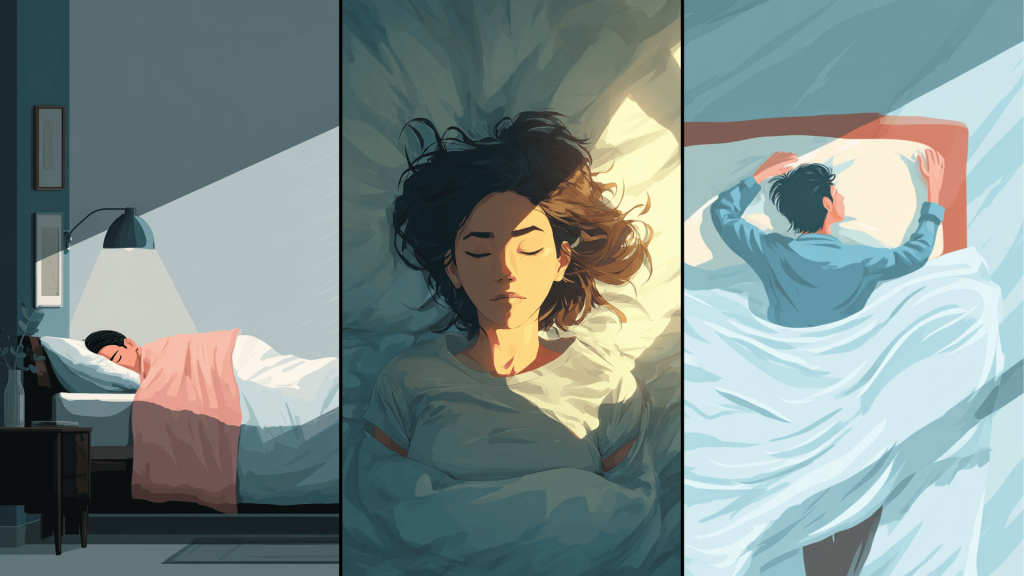
The way you sleep can put pressure on your upper back and shoulders without you even realizing it. Certain positions can strain the muscles around your shoulder blades, especially the rhomboids, while others can help your body relax and recover.
1. The Mechanics of Shoulder and Back Strain During Sleep
When you sleep in a position that pushes your shoulders forward, like lying on your stomach or curling up too tightly, it can stretch and strain the rhomboid muscles.
These muscles work to keep your shoulder blades pulled back. If they’re overextended for hours during the night, they may feel sore, tight, or even inflamed by morning.
A twisted upper spine or unsupported back can also cause tension to build around the shoulder blades. This is especially true if your mattress or pillows don’t give your body the support it needs. Over time, these small misalignments can lead to ongoing discomfort.
2. How to Sleep With Rhomboid Pain
The best way to sleep with rhomboid pain is to keep your spine and shoulders in a neutral position.
Try lying on your back with a pillow under your knees or on your side with a pillow between your legs and another supporting your upper arm. These setups help prevent your shoulders from rounding forward, which puts pressure on the rhomboids.
It’s also helpful to avoid stomach sleeping, since this often forces your neck and shoulders into awkward angles. Choosing a supportive mattress and pillows can further reduce strain and help you stay in a comfortable position through the night.
3. Why Posture Matters Overnight
Good posture isn’t just important during the day; it matters at night, too. While you’re asleep, your muscles and joints are meant to rest and recover. But if your spine, shoulders, or hips are out of line, your muscles may end up working overtime just to stay balanced.
Proper sleep posture helps keep your spine neutral and your shoulder blades in the right position. This reduces the risk of pulling or overloading the rhomboids.
Supporting your neck, shoulders, and hips with the right pillows can make a big difference in how you feel when you wake up.
4. Signs Your Sleep Setup May Be Worsening Pain
If your rhomboid pain gets worse in the morning or after naps, your sleep position could be part of the problem. You might notice that your shoulders feel tight, your upper back aches, or it takes time to loosen up after waking.
Other signs include waking up with numbness in your arms, frequent tossing and turning, or feeling like your mattress doesn’t support your upper back well.
These clues suggest it’s time to check your pillows, mattress, and the way you position your body at night.
Best Sleeping Positions for Rhomboid Pain
Your sleeping position plays a big role in how your upper back feels when you wake up. Some positions reduce stress on your rhomboid muscles, while others can make the pain worse overnight.
Back Sleeping With Shoulder and Knee Support
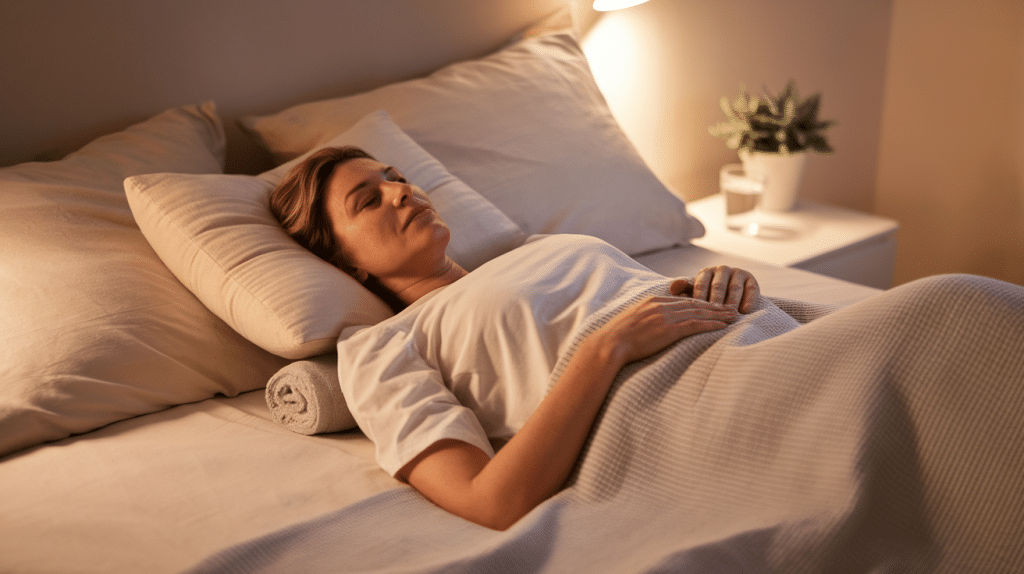
Sleeping on your back is one of the best positions for rhomboid pain. It keeps your spine in a straight, neutral line and helps your shoulders stay relaxed.
Place a small pillow under your knees to take pressure off your lower back. You can also place a rolled towel or thin pillow between your shoulder blades. This helps keep your chest open and prevents your shoulders from rounding forward.
This setup gives your upper back muscles, including the rhomboids, a chance to rest without strain.
Side Sleeping With Pillows for Support
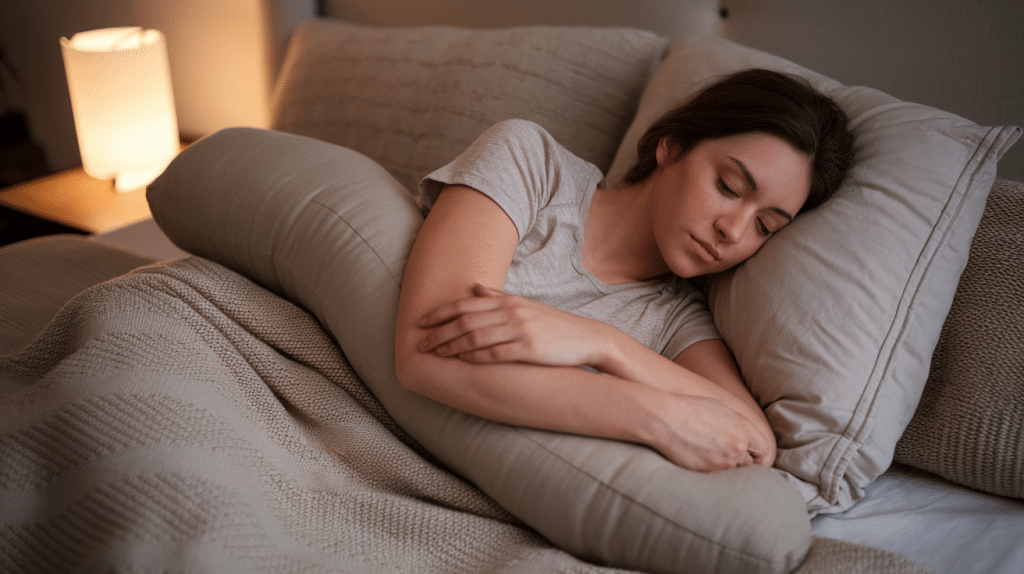
If you’re a side sleeper, you can still sleep comfortably with rhomboid pain. The key is to support your body so you don’t twist or slump forward during the night.
Use a pillow between your knees to keep your hips aligned. Then, hug a pillow or body pillow in front of you. This stops your top shoulder from rolling forward and pulling on your rhomboid area.
Make sure your head and neck are in line with your spine. Too much bending can strain your upper back.
Why You Should Avoid Sleeping on Your Stomach
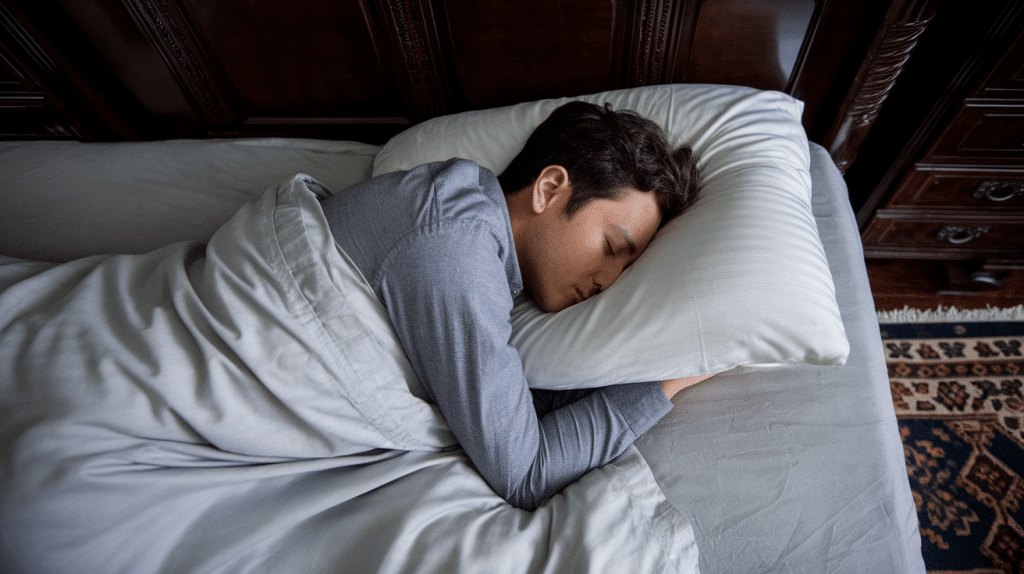
Stomach sleeping is the worst position for rhomboid pain. It forces your head to turn to one side, which can twist your spine and shoulders. It also pushes your shoulders forward, which overstretches the rhomboid muscles.
Even if you’re used to this position, switching to your back or side can help your muscles heal faster. Try placing a body pillow beside you to stop yourself from rolling onto your stomach while you sleep.
Other Ways to Improve Sleep Comfort
A good sleeping position is just one part of managing rhomboid pain. The right support and habits can make a big difference in how your back feels when you wake up.
Choose the Right Pillow and Mattress
Your pillow should support your neck without pushing it forward or letting it drop too low. Look for one that keeps your head in line with your spine.
For side sleepers, a slightly thicker pillow often works best. Back sleepers may prefer something medium-height and slightly firm.
A mattress that’s too soft can let your spine sink, which pulls on your upper back. One that’s too hard may cause pressure points. A medium-firm mattress is often the best choice for most people with rhomboid pain. Memory foam and hybrid mattresses can also help by keeping your spine aligned.
Try Gentle Stretches Before Bed
Stretching your upper back and shoulders before bed can help loosen tight muscles and reduce pain overnight. Focus on movements that open your chest and upper spine.
A few helpful stretches include:
- Cat-cow pose to warm up your spine
- Shoulder rolls to ease tension
- Chest openers with your arms behind your back
- Gentle upper back twists while seated
You only need 5 to 10 minutes. Don’t push into pain; keep the movements light and slow.
Use Heat to Relax Tight Muscles
Applying a warm compress or heat pack to your upper back for 15 to 20 minutes before bed can help your rhomboid muscles relax.
Heat increases blood flow and helps calm tight spots. Avoid using it overnight, but it’s great as part of your bedtime routine.
Daytime Habits to Help With Rhomboid Pain
What you do when you’re awake plays a big part in how your upper back feels when you’re asleep. These small daily habits can help reduce rhomboid pain and improve your sleep quality.
- Better posture while sitting and standing: Keep your shoulders back, chest open, and spine straight. Avoid slouching or hunching over screens for long periods.
- Ergonomic work setup: Raise your monitor to eye level, support your lower back, and keep your feet flat on the floor while working at a desk.
- Core and upper back strengthening: Do simple exercises like wall slides, bird-dogs, or band pulls to build the muscles that support your shoulder blades.
- Frequent movement breaks: Get up and stretch or walk every hour to prevent stiffness from setting in.
- Gentle daily stretching: Add upper body stretches throughout the day, like shoulder rolls or chest openers, to keep the rhomboids loose and mobile.
- Staying active overall: Light physical activity like walking, swimming, or yoga can keep your muscles balanced and prevent tightness from building up.
Building these habits into your routine can reduce the strain on your rhomboids, both during the day and while you sleep.
When to See a Professional
Most cases of rhomboid pain go away with rest, posture changes, and better sleep habits. But sometimes, the pain sticks around or gets worse over time. That’s when it’s smart to get help from a healthcare provider.
You should see a doctor or physical therapist if:
- The pain doesn’t improve after a few weeks of self-care
- It gets worse at night or with movement
- You feel tingling, numbness, or weakness in your arms or hands
- The pain is sharp, burning, or spreading across your back or chest
- You’re unsure what’s causing it and want a clear diagnosis
A physical therapist can check your posture, range of motion, and muscle strength. They’ll create a plan to stretch and strengthen your upper back without making the pain worse.
In some cases, rhomboid pain may be linked to a pinched nerve, disc issue, or joint problem. That’s why seeing a professional is important if things don’t improve.
Getting help early can prevent the pain from becoming a long-term issue and help you get back to sleeping comfortably.
Wrapping Up
Finding the right rhomboid pain sleeping position can make a huge difference in how well you sleep and how your back feels throughout the day.
I’ve found that a few simple changes to your sleep setup and posture can ease that nagging discomfort and help your body recover.
Try adjusting your position, using the right pillow support, and adding some light stretching or posture work to your daily routine. Small changes tonight could mean a much better morning tomorrow.
You don’t have to just live with back pain. A good sleep position is part of taking care of yourself long-term.
If this helped, there’s plenty more to learn. Check out my other blogs for real-world tips on posture, pain relief, and sleep health that actually work.

